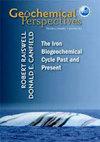A journey in Noble Gas Cosmochemistry and Geochemistry
IF 2.5
3区 地球科学
Q1 GEOCHEMISTRY & GEOPHYSICS
引用次数: 1
Abstract
I started my journey in science by studying noble gases implanted by the solar wind in dust grains on the surface of the Moon, and with many colleagues I have studied solar wind implanted noble gases in natural and artificial samples throughout my career, the latter exposed primarily by the Genesis space mission. Major questions are what noble gases in the solar wind can tell us about the present and the past Sun, and how they can contribute to understanding the formation and history of the planets and their building blocks, represented, for example, by meteorites. Since my early years as a postdoc, I have also been interested in noble gases (and radioactive nuclides) produced in meteorites and other extraterrestrial samples by interactions with energetic elementary particles from galactic cosmic radiation (and the Sun). These so called “cosmogenic” nuclides allow us to study the transport of meteorites to Earth, and the dynamics of the top surface layers (“regoliths”) on the Moon, asteroids, and comets. Cosmogenic noble gases are also crucial for studying even more exotic topics such as the history of tiny presolar grains that formed in the cooling envelopes of earlier generations of stars towards the end of their lives and were eventually incorporated into the meteoritic matter where they are found today. Cosmogenic noble gases in some tiny phases in meteorites are also likely tracers of our highly active Sun at a very early stage in its history. A few years later, I started my third major research topic in cosmochemistry, the study of primordial noble gases in meteorites and other extraterrestrial samples. These noble gases were incorporated into meteorites or their precursors in the early solar system or even in a presolar environment. I also participated in studies by colleagues of isotopic anomalies of other elements important in cosmochemistry, my expertise being mainly in aspects of the influence of cosmic rays on these elements. Although working in an Earth Science institution, it took quite a while before I started to also study noble gases (and radionuclides) in terrestrial samples. This is described in the second part of this contribution. A major focus was on cosmogenic noble gases and radionuclides produced in samples near the Earth’s surface. Although production rates of cosmogenic nuclides on Earth are several orders of magnitude lower than in space, making their analysis more challenging, they have become an important tool in geomorphology. Because stable noble gas nuclides are particularly well suited to the study of ancient landscapes, much of our work focused on areas with arid climates, such as Antarctica and the Andes in Chile, in collaboration with geoscience colleagues. We also participated in the large multinational CRONUS collaboration, funded by the European Union, a community effort to improve our knowledge of nuclide production rates at the Earth’s surface. In another major collaboration with external colleagues we are involved in noble gas analyses of water samples, ranging from lakes to aquifers to tiny inclusions in stalagmites. This research focuses on studying lake and groundwater dynamics, including contributions of mantle-derived noble gases such as in volcanic lakes. Atmospheric noble gases dissolved in suitable samples are also palaeotemperature indicators, supplementing information from other proxies such as oxygen isotopes.稀有气体宇宙化学和地球化学之旅
我的科学之旅始于研究太阳风在月球表面尘埃颗粒中注入的稀有气体,在我的职业生涯中,我与许多同事一起研究了太阳风在天然和人造样本中注入的惰性气体,后者主要是在创世纪太空任务中暴露的。主要问题是太阳风中的稀有气体可以告诉我们现在和过去的太阳,以及它们如何有助于理解行星及其组成部分的形成和历史,例如陨石。自从我早年做博士后以来,我也对陨石和其他地外样本中通过与银河系宇宙辐射(和太阳)中的高能基本粒子相互作用产生的稀有气体(和放射性核素)感兴趣。这些所谓的“宇宙成因”核素使我们能够研究陨石向地球的传输,以及月球、小行星和彗星顶表面层(“风化层”)的动力学。宇宙成因惰性气体对于研究更具异国情调的主题也至关重要,例如在前几代恒星生命末期的冷却包层中形成的微小太阳前颗粒的历史,这些颗粒最终被纳入今天发现的陨石物质中。陨石中一些微小相中的宇宙成因惰性气体也可能是我们历史早期高度活跃的太阳的示踪剂。几年后,我开始了我在宇宙化学方面的第三个主要研究课题,即陨石和其他地外样本中原始稀有气体的研究。这些稀有气体在早期太阳系甚至在前太阳系环境中被并入陨石或其前身中。我还参与了同事们对宇宙化学中其他重要元素同位素异常的研究,我的专业知识主要是宇宙射线对这些元素的影响。尽管我在地球科学机构工作,但我花了很长一段时间才开始研究地球样本中的稀有气体(和放射性核素)。本文第二部分对此进行了描述。主要关注的是地球表面附近样本中产生的宇宙成因惰性气体和放射性核素。尽管地球上宇宙成因核素的产生率比太空中低几个数量级,使其分析更具挑战性,但它们已成为地貌学的重要工具。由于稳定的稀有气体核素特别适合研究古代景观,我们与地球科学同事合作,将大部分工作集中在气候干旱的地区,如南极洲和智利的安第斯山脉。我们还参加了由欧洲联盟资助的大型多国CRONUS合作,这是一项社区努力,旨在提高我们对地球表面核素生产率的了解。在与外部同事的另一项重大合作中,我们参与了对水样的惰性气体分析,从湖泊到含水层,再到石笋中的微小内含物。这项研究的重点是研究湖泊和地下水动力学,包括地幔衍生的稀有气体的贡献,如火山湖。溶解在合适样本中的大气稀有气体也是古温度指标,补充了氧同位素等其他指标的信息。
本文章由计算机程序翻译,如有差异,请以英文原文为准。
求助全文
约1分钟内获得全文
求助全文
来源期刊

Geochemical Perspectives
GEOCHEMISTRY & GEOPHYSICS-
CiteScore
0.80
自引率
0.00%
发文量
1
期刊介绍:
Each issue of Geochemical Perspectives presents a single article with an in-depth view on the past, present and future of a field of geochemistry, seen through the eyes of a highly respected member of our community. The articles combine science and history of the field’s development and the scientist’s opinions about future directions. We expect personal glimpses into the author’s scientific life, how ideas were generated, pitfalls and triumphs along the way, and how ideas were adopted to carry our field further. Perspectives articles are intended for the entire geochemical community, not for experts. They are not reviews or monographs or text books. They go beyond the current state of the art, providing opinions about future directions and impact in the field.
 求助内容:
求助内容: 应助结果提醒方式:
应助结果提醒方式:


